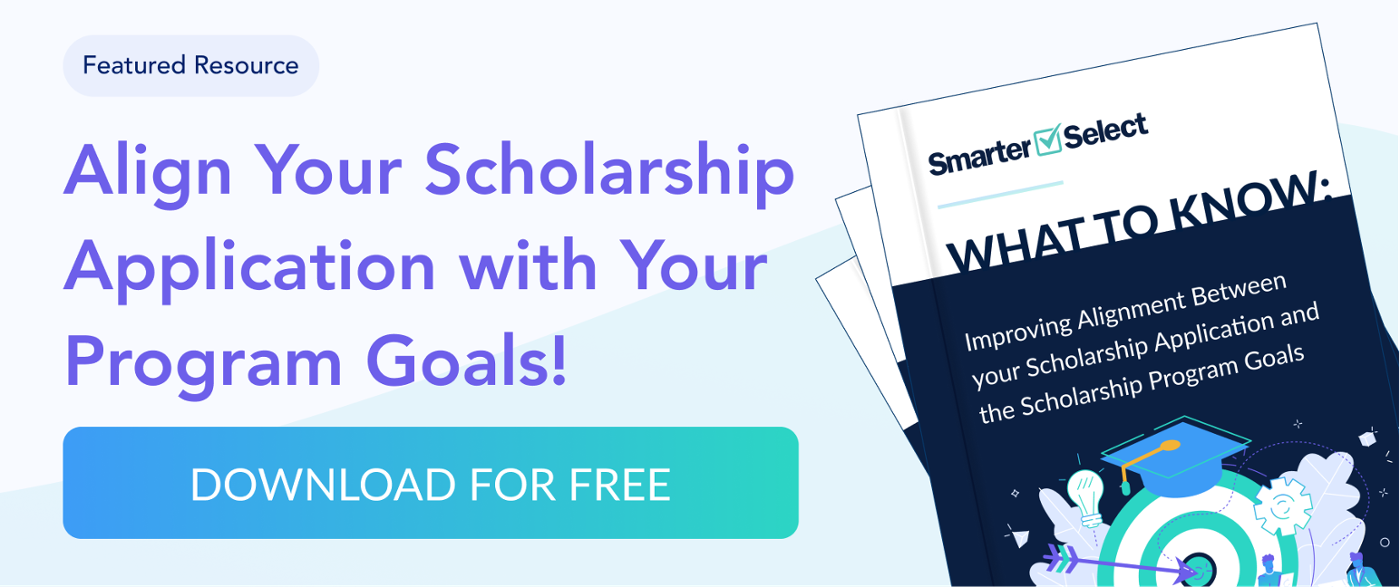The Importance of Establishing Your Scholarship Program Goals
Scholarships are an excellent way for students to fund their education and receive recognition for their talents. However, as any scholarship program manager worth their weight can tell you, not all scholarship programs are the same. They vary widely in what they offer and who they target.
Unfortunately, a lot of program managers aren’t drawing in the ideal candidates they are looking for. They have a vague idea of who that perfect recipient is, but they’re mostly just taking shots in the dark hoping something lands that makes everyone, namely their donors and/or community partners, happy.
That said, establishing concrete goals for your program is the first step in ensuring that you are attracting suitable applicants. Do this first and when you create a scholarship application, the form will practically write itself.
For example, if a scholarship is looking for well-rounded students who excel both in the classroom and extracurricular activities, the questions in the application should reflect this. The application could ask questions about what candidates are achieving beyond their grades. This can include:
- What kind of hobbies do you have?
- Are you doing volunteer work?
- What about clubs?
- Have you worked on any community service projects?
But, we’re getting a little ahead of ourselves. How do you create a set of goals for your scholarship program?
How to Start A Scholarship Program With The Right Goals
A scholarship with specific goals, also known as a niche scholarship, targets a very specific student demographic. In business, companies create what is commonly referred to as an ideal customer avatar. The same can be done with a scholarship. Create an ideal recipient avatar to be your guiding light in your scholarship program.

Consider the following questions:
- Are they enrolled in school full-time?
- Are they still in high school, or already in college, and struggling to pay for their education?
- Do their grades matter?
- ie. Will this scholarship be merit-based?
- What is their financial need? Low, medium, or high?
- Is your scholarship needs-based?
- What is their geographic location?
Now, go another layer deeper as you consider the ideal recipient.
- What does this person hope to achieve in the future?
- What is their area of study?
- What stands out about them?
- Does their marital status matter?
- Are they currently employed?
You may also need to ask yourself where your donors stand. Are they looking for someone that meets criteria you’re not thinking about?
Pro tip: Establish your scholarship program goals before seeking donors.
When you have a specific type of person you’re trying to help, it becomes easier to attract donors too. If you go about this in the reverse order, you may attract donors that have a different recipient in mind compared with your team’s ideal recipient and things can get out of hand quickly.
Starting a Scholarship Program that Better Serves Applicants
Once established, your scholarship program goals will act as an outline when creating applications, reviewing candidates, and finally selecting the recipients to distribute the scholarship funds. Goals make everything more efficient. It’s much easier to attract the right people and filter out unqualified candidates when you have a firm set of criteria and know exactly who you’re looking for.

Another way to make sure that your scholarship attracts the right people is through its application. And again, it’s much less taxing to create a scholarship application after establishing your goals. Your goals not only make things easier on your team, it actually acts to better serve your applicants too. They won’t waste their time filling out applications for programs they are unqualified for. Instead, they will know instantly if your program is a good fit for them from the messaging of your marketing materials and even the questions you ask in your form.
Remember that while you may want a well-rounded applicant, you want to attract the right people. A diverse candidate pool is wonderful, but the applicants in it must also meet the criteria you have set for your goals to be achieved.
Better Serve Your Evaluators and/or Volunteers
To save time, it's helpful to standardize the evaluation process for each applicant. There are many ways to do this, including auto-scoring or essay rubrics. When the applicant's responses are automatically scored, it allows the evaluator to quickly see where the student falls in relation to each criterion or which areas they excel in.
Essay rubrics help create a formula for how to score an essay. A section is designed for each criterion with a series of points that the scholarship evaluator can add or subtract based on criteria within the essay. You can use a scholarship requirements template to make quick work of your scoring rubrics if you’re using a quality scholarship management software.
This saves time when scoring large numbers of applicants and ensures a more consistent application evaluation across evaluators. Whether you have a paid team or a group of volunteers, saving time is critical.
You want to ensure everyone’s experience will be enjoyable and rewarding. Make your volunteers and paid team members feel like they are a part of your organization working towards the mission of the scholarship being offered.
It may be beneficial to offer incentives for their time and involvement as well. Some of these incentives could be offering feedback on the scholarship program itself and the application or serving as a mentor to the scholarship recipient. Simple actions like this can keep your team enthusiastic about their involvement because it becomes about something greater than them.
Create a Solid Timeline for Goal Achievement
Start planning ahead, as it may take some time to create a new application and develop relationships with past applicants, volunteers, donors, and team members. Any changes should be made well in advance of your scholarship application deadline.
Get everyone on board to help make any changes quickly and efficiently while still allowing time for more revisions and modifications to be made. Begin developing your timeline preparations at least four months ahead of time with a progress review at three months out and again at two months.

Have your application ready at least one month before you allow students to start submitting their applications. Have team members fill out the application to get an idea of how easy/hard it is to fill out as well. This will ensure you have ample time to minimize hiccups and mistakes that may occur during the application process.
To make the application process as painless as possible, be sure to use SmarterSelect. Our software helps scholarship program managers like you save time and money. Learn more about what we can do for your program. Start your free trial now.



